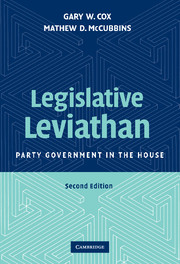Book contents
- Frontmatter
- Contents
- List of Figures
- List of Tables
- Acknowledgments
- Legislative Leviathan
- Introduction
- PART ONE THE AUTONOMY AND DISTINCTIVENESS OF COMMITTEES
- PART TWO A THEORY OF ORGANIZATION
- PART THREE PARTIES AS FLOOR-VOTING COALITIONS
- PART FOUR PARTIES AS PROCEDURAL COALITIONS
- PART FIVE PARTIES AS PROCEDURAL COALITIONS
- Conclusion
- Appendix 1 Uncompensated Seniority Violations, Eightieth through Hundredth Congresses
- Appendix 2 A Model of the Speaker's Scheduling Preferences
- Appendix 3 Unchallengeable and Challengeable Vetoes
- Appendix 4 The Scheduling Power
- Bibliography
- Author Index
- Subject Index
PART FIVE - PARTIES AS PROCEDURAL COALITIONS
THE SCHEDULING POWER
Published online by Cambridge University Press: 05 June 2012
- Frontmatter
- Contents
- List of Figures
- List of Tables
- Acknowledgments
- Legislative Leviathan
- Introduction
- PART ONE THE AUTONOMY AND DISTINCTIVENESS OF COMMITTEES
- PART TWO A THEORY OF ORGANIZATION
- PART THREE PARTIES AS FLOOR-VOTING COALITIONS
- PART FOUR PARTIES AS PROCEDURAL COALITIONS
- PART FIVE PARTIES AS PROCEDURAL COALITIONS
- Conclusion
- Appendix 1 Uncompensated Seniority Violations, Eightieth through Hundredth Congresses
- Appendix 2 A Model of the Speaker's Scheduling Preferences
- Appendix 3 Unchallengeable and Challengeable Vetoes
- Appendix 4 The Scheduling Power
- Bibliography
- Author Index
- Subject Index
Summary
In the previous part, we investigated one of the key structural powers of the parties – the power to appoint the members of the standing committees. We presented statistical evidence that members more loyal to the party leadership have been more likely to receive desirable committee assignments throughout the postwar era; we also showed that most contingents have been representative of the party from which they were drawn and that the exceptions are predictable.
Another key structural power is the ability to set the legislative agenda. This power is shared by the majority party leaders and the committee chairs. In Chapter 9 we emphasize the degree to which competition between committees for scarce time on the floor leads to anticipation and accommodation of the wishes of the majority-party leadership; we also consider the partisan implications of veto power. Chapter 10 then turns to a variety of empirical indicators of the extent to which the majority party has succeeded in controlling in the agenda in the postwar era.
- Type
- Chapter
- Information
- Legislative LeviathanParty Government in the House, pp. 211 - 212Publisher: Cambridge University PressPrint publication year: 2007



